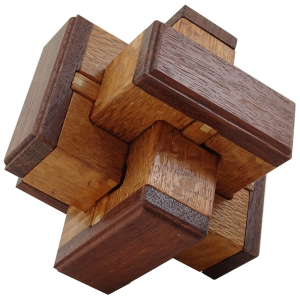International Puzzle Party 30 Osaka & Hakone, Japan
10 July 2010The 30th International Puzzle Party was held in two locations in Japan in July 2010. We enjoyed meeting puzzle friends in Osaka first then travelled…


The ultimate goal is to find the piece of Australiana inside the puzzle.
At the end of the solve you will find a small compartment that holds a piece of Lightning Ridge opal. Don’t get your hopes up, whilst it is a small piece of genuine opal from the Lightning Ridge opal field, the compartment is small and it’s not the Aurora Australis!
Looking for a simple puzzle you can solve easily? This is not going to be it.
Looking for a quick solve? That’s not going to happen.
This may not be the hardest puzzle in the world but if you think about the Coming of Age MkII combined with the SMS Box with fewer pieces and fewer tools. You have it!
The puzzle has trick locks, tools, elements of sequential discovery but essentially it’s a very hard burr puzzle. If you’re looking for a walk in the park don’t buy this one.
Brian has included ideas in this puzzle that he’s never seen in a puzzle before. Solving a new puzzle often draws on previous puzzle-solving experiences so having lots of puzzles in your collection can be a big help. But the inclusion of ideas not seen before instantly bumps up the difficulty a lot.
The puzzle is called ages. Why?
Even though Brian had always designed his burr puzzles in his head he has found BurrTools to be an amazing tool to help with analysing and refining the design.
But when he first plugged some pieces into BurrTools to check for solutions Andreas Röver’s wicked sense of humour was immediately obvious. Time left: ages
In fact, the full analysis of the selection of pieces has never been completed in BurrTools. Time left: unknown -> days -> years -> millennia -> ages Who knows how long it might take? Once he found a few designs with more than 30 moves to remove the first piece he thought that would be enough.
The design of the puzzle was first started in 2010, a whole year before IPP31 in Berlin, plenty of time to design what was going to be the Berlin Beer Burr.
Brian then hit upon the idea for the Houdini puzzle and Berlin being where Houdini performed the famous Torture Cell act it just seemed the right time to make that puzzle and that it should be given in the Berlin IPP31 exchange and as a result, the Berlin Beer Burr (now named ages) got shelved.
So Brian’s had plenty of time to revisit and redesign the original burr and that process seems to have taken ages right? Yet another reason for the name.
This is not a binary burr even if it seems to have some of the elements. All the moves are random. That makes it less predictable to solve. And the burr has no frame; even the Coming of Age MkII pieces are technically making a frame which is how they can get so many moves. But how to get so many moves without a frame and still keep it stable while you play with it? Brian thinks he has done that here.
The first burr piece can be removed without any rotational moves but things are not so straightforward after that. Although Brian has left some rotational moves in the puzzle there is definitely no force required to rotate them so if it’s a tight fit then it probably isn’t meant to rotate. More than half the pieces have been strengthened with splines but don’t forget this puzzle is made of wood, not metal so no undue force, please.
All tools have been provided to do this puzzle. No external tools and no hitting is required.
Brian’s favourite puzzles have always been high-level burrs. He created the Coming of Age MkII in 2000 because he liked the mystery of where multiple steps can lead you; towards a solution or to a complete dead-end from which you must then navigate back. Similar to a sequential discovery puzzle where you step towards the solution. It’s just that with sequential discovery there is the added dimension of tools.
Size: 110mm x 110mm x 110mm
Materials: The puzzle is made of Queensland Silky Oak & Western Australian Jarrah wood and includes magnets and brass parts.
Solution: We will publish the solution but not until all puzzles have been sold. We want everyone to have the same chance as everyone else to solve without fear of spoilers.
The puzzle will not work if you put it into BurrTools. The software cannot do the rotational moves and some pieces have been changed to incorporate the sequential discovery elements.
If you’re desperate for a helping hand we can supply a solution for the difficult burr part of the puzzle with a few fudged pieces. Some pieces will be missing from the file.